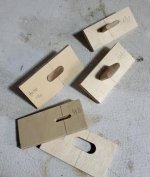Available by pre-order until August 7th at noon. Delivery expected for September 2024.
FastCap's new Domino Mortise Markers bring precision to woodworking. Insert the marker into a pre-cut mortise, align it with the joint location, and tap with a hammer to create a clear mark. For harder woods, use an inked stamp pad for better visibility.
Mortise Marker Regular Set:
FastCap's Mortise Markers ensure precise and efficient joinery, making them an essential addition to your toolkit.
Pre-Order Now

FastCap's new Domino Mortise Markers bring precision to woodworking. Insert the marker into a pre-cut mortise, align it with the joint location, and tap with a hammer to create a clear mark. For harder woods, use an inked stamp pad for better visibility.
Mortise Marker Regular Set:
- Ideal for the Festool Domino Joiner DF 500 Q and includes 4mm, 5mm, 6mm, 8mm, and 10mm sizes.
- Made for the Festool Domino XL DF 700 Joiner and includes 8mm, 10mm, 12mm, and 14mm sizes.
FastCap's Mortise Markers ensure precise and efficient joinery, making them an essential addition to your toolkit.
Pre-Order Now




